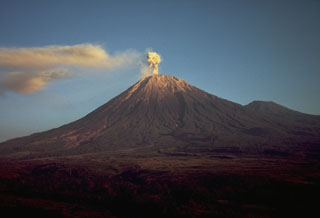Report on Semeru (Indonesia) — 11 January-17 January 2023
Smithsonian Institution / US Geological Survey
Weekly Volcanic Activity Report, 11 January-17 January 2023
Managing Editor: Sally Sennert.
Please cite this report as:
Global Volcanism Program, 2023. Report on Semeru (Indonesia) (Sennert, S, ed.). Weekly Volcanic Activity Report, 11 January-17 January 2023. Smithsonian Institution and US Geological Survey.
Semeru
Indonesia
8.108°S, 112.922°E; summit elev. 3657 m
All times are local (unless otherwise noted)
PVMBG reported that the eruption at Semeru continued during 3-10 January with daily ash plumes of variable densities rising above the summit. At 0737 on 10 January white-and-brown ash plumes rose 500 m above the summit and drifted N. A gray-to-brown ash plume at 0532 on 11 January rose 200 m and drifted N. White-to-gray ash plumes were visible at 0552, 0621, and 0710 on 11 January, and at 0629 and 0723 on 12 January rising 200-500 m above the summit and drifting N, W, and SW. At 0525 on 13 January a white-and-brown ash plume rose 700 m and drifted S. A white-to-gray ash plume rose 500 m and drifted SW at 0627 and a dense ash plume rose 1 km and drifted SW at 0802. At 0502 on 14 January a dense white-and-gray ash plume rose 700 m and drifted SW. Multiple white, gray, and brown ash plumes on 15 January rose as high as 400 m and drifted N, NE, and SW. Four gray ash plumes visible on 16 January (at 0558, 1613, 1627, and 1655) rose as high as 700 m and drifted NW, N, and NE. The Alert Level remained at 3 (on a scale of 1-4). The public was warned to stay at least 5 km away from the summit, and 500 m from Kobokan drainages within 17 km of the summit, along with other drainages originating on Semeru, including the Bang, Kembar, and Sat, due to lahar, avalanche, and pyroclastic flow hazards.
Geological Summary. Semeru, the highest volcano on Java, and one of its most active, lies at the southern end of a volcanic massif extending north to the Tengger caldera. The steep-sided volcano, also referred to as Mahameru (Great Mountain), rises above coastal plains to the south. Gunung Semeru was constructed south of the overlapping Ajek-ajek and Jambangan calderas. A line of lake-filled maars was constructed along a N-S trend cutting through the summit, and cinder cones and lava domes occupy the eastern and NE flanks. Summit topography is complicated by the shifting of craters from NW to SE. Frequent 19th and 20th century eruptions were dominated by small-to-moderate explosions from the summit crater, with occasional lava flows and larger explosive eruptions accompanied by pyroclastic flows that have reached the lower flanks of the volcano.
Source: Pusat Vulkanologi dan Mitigasi Bencana Geologi (PVMBG, also known as CVGHM)

